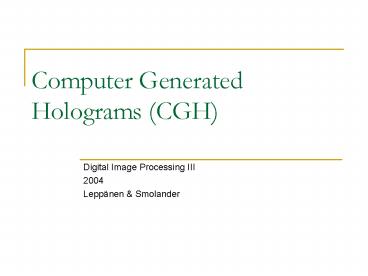Computer Generated Holograms CGH - PowerPoint PPT Presentation
1 / 11
Title:
Computer Generated Holograms CGH
Description:
Compute the mathematical hologram (or amplitude and phase distribution) ... To reproduce an object as a hologram we need to reproduce the intensities and ... – PowerPoint PPT presentation
Number of Views:1196
Avg rating:3.0/5.0
Title: Computer Generated Holograms CGH
1
Computer Generated Holograms (CGH)
- Digital Image Processing III
- 2004
- Leppänen Smolander
2
Contents
- Introduction to CGH
- Mathematical Models
- Methods for Encoding and Recording
- Reconstruction
3
Introduction to CGH (1)
- Basic stages in the synthesis of CGH
- Find mathematical model for the object and usage
- Compute the mathematical hologram (or amplitude
and phase distribution) - Encode samples of the mathematical hologram
- Record the hologram on the physical medium
Computer
Complex amplitude
Computing mathematical hologram
Mathematical model
Usage model
DA conversion
Encoding
Recording
4
Introduction to CGH (2)
- Major applications of CGH
- Spatial filters for optical information
processing - Optical elements e.g. beam formers, deflectors,
special diffraction gratings, and information
display - Here we focus mainly on display holograms
5
Mathematical Models (1)
- To reproduce an object as a hologram we need to
reproduce the intensities and phases of the light
waves scattered by the object - If monochromatic illumination is considered only
wave amplitude and phase is needed - Objects ability to reflect and scatter light can
be described by a radiation reflection factor,
complex function - o(x,y,z) o(x,y,z)expiT(x,y,z)
- Light wave field over an object can be described
by a wave propagation integral over the objects
surface - Needed 3D integral can be reduced to 2D by taking
into consideration natural limitations of visual
observation - Integral depends on geometrical dimensions of the
object and distance of the object from the
observation plane
6
Mathematical Models (2)
- Further simplifications
- Fresnel hologram
- Fourier hologram
- Both can be computed with DFT
Parallel light source
Point light source
Hologram
Hologram
Fresnel hologram
Fourier hologram
7
Methods for Encoding and Recording (1)
- Three types of optical media
- Amplitude-only
- Phase-only
- Combined amplitude/phase
- Amplitude-only media
- Controllable parameter is the light intensity
transmission - Most common (e.g. silver galid photographic
emulsion in photography) - Phase-only
- Controllable parameter is the optical thickness
- E.g. thermoplastic materials, recently micro-lens
and mirror arrays
8
Methods for Encoding and Recording (2)
- Combined amplitude/phase media
- Both parameters, light intensity transmission and
optical thickness, can be controlled - Photographic materials with several layers for
different wavelengths - No specific recording devices available computer
printer and display devices are used instead
which have some drawbacks (binary media) - Recording methods can be categorized e.g. respect
to methods of representing complex numbers
(samples of mathematical hologram)
9
Methods for Encoding and Recording (3)
Exponential representation
Combined media
On axis hologram
Phase-only media
Kinoform
Amplitude- only media
Symmetrization
Detour phase
Binary media
Additive representation
Double-phase method
Phase-only media
Multiple phase method
Binary media
Representation by Orthogonal and
bi- orthogonal components
Amplitude- only media
2D-symplex representation
Explicit spatial carrier methods
10
Reconstruction
- In the reconstruction CGH (discrete) are
subjected to analog optical transformation
(consider as digital to analog conversion) - Characteristics of a recording device that affect
the reconstruction - Type of discretization raster
- Discretization intervals
- Recording aperture
- Physical size of recorded hologram
- An example of symmetrization method on an
amplitude-only medium given in the book
11
Source
- Digital Holography and Digital Image Processing -
Principles, Methods, Algorithms, Leonid
Yaroslavsky, Kluwer Academic Publishers 2004

